| Golden Journal No. 37: Heavy Metal
The Heavy Metal
By Mike Bennighof, Ph.D.
April 2024
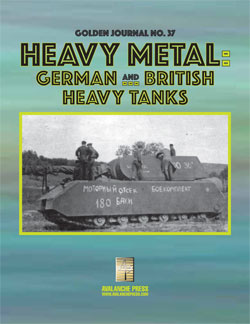 Some years back, we published a Panzer Grenadier expansion book we called Secret Weapons. We printed its pieces alongside the third, half-sized sheet from Elsenborn Ridge, our best-selling Panzer Grenadier title. Which meant that when Secret Weapons had outlived its shelf life, we still had a lot of pieces left over. Some years back, we published a Panzer Grenadier expansion book we called Secret Weapons. We printed its pieces alongside the third, half-sized sheet from Elsenborn Ridge, our best-selling Panzer Grenadier title. Which meant that when Secret Weapons had outlived its shelf life, we still had a lot of pieces left over.
Rather than build a new book around them, I decided to use some of them - the 49 pieces with heavy tanks and close-support planes - in a new Golden Journal. And that’s the centerpiece of Golden Journal No. 37: Heavy Metal.
Heavy Metal has some true heavy metal: 22 German tanks, 18 British tanks, three German heavy anti-tank guns, two German airplanes and four lone German guys with a missile launcher. Let’s have a look at them, starting with the German heavy tanks.
Who’s the Leader of the Club?
 
Why, that would be Panzer Maus. The largest tank ever actually built (though it never entered production), the Maus heavy tank weighed in at 188 tons. Had it ever been built in numbers, it surely would have been a war-winning weapon - for the Allies, wasting huge amounts of steel, energy, labor and engineering expertise.
Panzer Maus is a monster of a tank, armed with a 128mm main gun, a 75mm secondary gun, plus one machine gun. That one machine gun probably would have been quickly seen to be a mistake, since the tank could only trundle along at 18 kilometers per hour – a running man could overtake it. And then attach some exploding something to it. Panzer Maus makes for a powerful barely-mobile anti-tank fortress, but it shouldn’t be mistaken for anything more than that.
An alternative super-heavy tank, the E100 or Tigermaus, makes it appearance, too. Here we’ve called it the Tiger III, since it was a greatly enlarged Tiger II and “Tigermaus” doesn’t fit on the game piece. It wasn’t quite as large as Panzer Maus, with a bigger main armament and a bigger engine but some potentially fatal flaws in its armor scheme; unlike Panzer Maus its armor would not have withstood the fire of heavy cruisers. And unlike Panzer Maus it was (barely) mobile, not very mobile but faster than enemy infantry.
Main Battle Tank
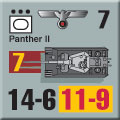
The concept of a main battle tank, or “universal tank,” had already been discussed in the late 1930’s. It wouldn’t become reality until the 1960’s, with the appearance of the American M60 series, the Soviet T62 and the West German Leopard 1. The proposed Panther II would have had armor as thick as any existing heavy tank (though less than Panzer Maus or Tigermaus), reasonable speed (though less than the original Panther, at least those Panthers that didn’t break down when started up), and the same long 88mm cannon as the Tiger II. All of that makes for a formidable battlefield opponent.
Anti-Aircraft Tanks
 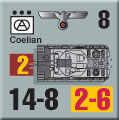
Once the German Air Force lost control of the skies over Europe, the German Army looked for more ways to protect itself from enemy air power. A number of makeshift solutions appeared, like the Möbelwagen (“moving van”), a Panzer IV chassis with an anti-aircraft gun plopped atop it. The Kugelblitz and Coelian anti-aircraft tanks offered a far more elegant solution. The Kugelblitz had a ball turret mounted in a ring-trace, originally developed to be mounted on submarines, with a pair of 30mm anti-aircraft guns. Choosing a brand-new gun to mate with a brand-new mount was probably not a wise decision, but certainly the Dozen-Year Reich made worse ones.
Flakpanzer Coelian carried a pair of 37mm anti-aircraft guns in a more traditional turret; the mockup (no prototype was ever made) bears a striking resemblance to the Soviet ZSU-57 and the U.S. Army’s Sergeant York self-propelled anti-aircraft guns. Both of the German vehicles are pretty good against infantry, but they are deeply vulnerable to anything able to hurt a tank.
Anti-Tank Weapons
 
The missile age comes to Panzer Grenadier, with the German X7 “Little Red Riding Hood” wire-guided anti-tank missile. They’re very effective, and give even light infantry forces a serious anti-tank capability. The X7 may have seen action in April 1945, claiming a pair of Soviet T-34/85 tanks. Or perhaps not. It’s not a very mobile system, but it can knock out even the British Tortoise ultra-heavy tank.
Missiles became the tank-killing weapons of choice because an anti-tank gun able to penetrate the battleship-scale armor of the latest heavy tanks was too large and heavy for battlefield use. A prime example is the German 128mm gun, derived from a very effective anti-aircraft weapon. Armor-piercing performance was not far different from the deadly 88mm gun, but the bigger weapon could kill enemy tanks at a much longer range and it fired a heavier high-explosive shell. It was also so heavy that it could not be moved without serious effort; in game terms, the 128mm piece has no limbered side as it is immobile.
Giant British Tanks
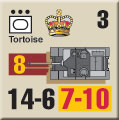 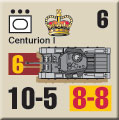 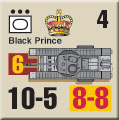
In contrast to the miserable failures produced by the German heavy tank program, Britain’s Centurion would become the main battle tank of many of the world's armies for the next 40 years; a handful of them soldiered on into this century. With the very effective 17-pounder in the earliest models (later upgraded) and good protection, the Centurion was slower than most foreign tanks but as a whole most British tank designs were not as fast as those of other nations.
The Centurion's success made the Black Prince infantry tank obsolete as soon as it entered service. A development of the Churchill tank, the Black Prince also had the 17-pounder gun and a level of protection similar to the Centurion, but like all British infantry tanks it was quite slow (a stunning seven miles per hour; we may have over-rated it).
Even slower was Britain's answer to the same questions that gave the U.S. Army its T28 assault gun: a massively armored vehicle designed to attack fortifications. The Tortoise was slow and heavily armored, with new 32-pounder anti-tank gun, and ultimately it never saw combat. But it proved to the world that Britain could produce a tank as huge and useless as that of any other Great Power.
The Golden Journal is only available to the Gold Club (that’s why we call it the Golden Journal).
Click here to join the Gold Club.
See your Gold Club Insider newsletter for ordering information.
Sign up for our newsletter right here. Your info will never be sold or transferred; we'll just use it to update you on new games and new offers.
Mike Bennighof is president of Avalanche Press and holds a doctorate in history from Emory University. A Fulbright Scholar and NASA Journalist in Space finalist, he has published a great many books, games and articles on historical subjects; people are saying that some of them are actually good.
He lives in Birmingham, Alabama with his wife and three children. He misses his dog, Leopold.
Want to keep Daily Content free of third-party ads? You can send us some love (and cash) through this link right here.
|
